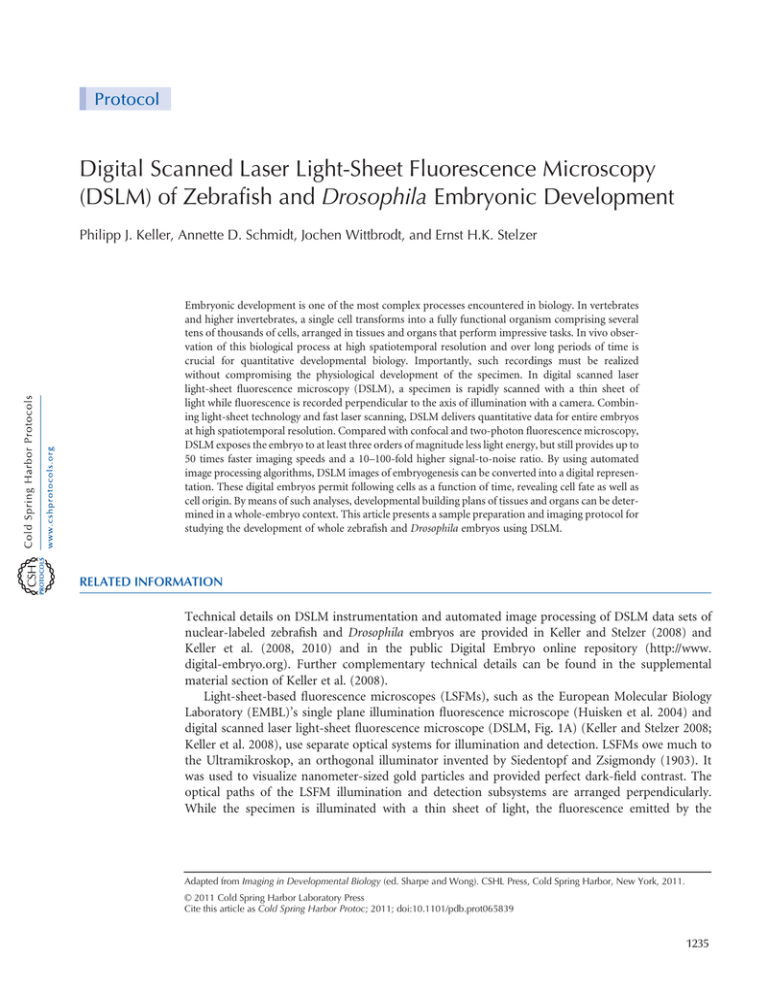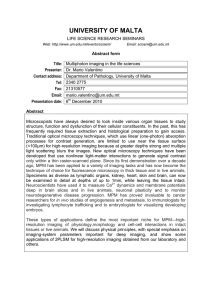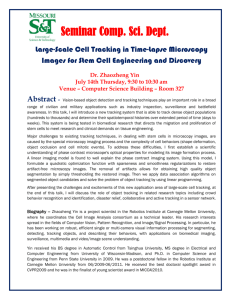Digital Scanned Laser Light-Sheet Fluorescence Microscopy (DSLM
advertisement

Protocol Digital Scanned Laser Light-Sheet Fluorescence Microscopy (DSLM) of Zebrafish and Drosophila Embryonic Development Philipp J. Keller, Annette D. Schmidt, Jochen Wittbrodt, and Ernst H.K. Stelzer Embryonic development is one of the most complex processes encountered in biology. In vertebrates and higher invertebrates, a single cell transforms into a fully functional organism comprising several tens of thousands of cells, arranged in tissues and organs that perform impressive tasks. In vivo observation of this biological process at high spatiotemporal resolution and over long periods of time is crucial for quantitative developmental biology. Importantly, such recordings must be realized without compromising the physiological development of the specimen. In digital scanned laser light-sheet fluorescence microscopy (DSLM), a specimen is rapidly scanned with a thin sheet of light while fluorescence is recorded perpendicular to the axis of illumination with a camera. Combining light-sheet technology and fast laser scanning, DSLM delivers quantitative data for entire embryos at high spatiotemporal resolution. Compared with confocal and two-photon fluorescence microscopy, DSLM exposes the embryo to at least three orders of magnitude less light energy, but still provides up to 50 times faster imaging speeds and a 10–100-fold higher signal-to-noise ratio. By using automated image processing algorithms, DSLM images of embryogenesis can be converted into a digital representation. These digital embryos permit following cells as a function of time, revealing cell fate as well as cell origin. By means of such analyses, developmental building plans of tissues and organs can be determined in a whole-embryo context. This article presents a sample preparation and imaging protocol for studying the development of whole zebrafish and Drosophila embryos using DSLM. RELATED INFORMATION Technical details on DSLM instrumentation and automated image processing of DSLM data sets of nuclear-labeled zebrafish and Drosophila embryos are provided in Keller and Stelzer (2008) and Keller et al. (2008, 2010) and in the public Digital Embryo online repository (http://www. digital-embryo.org). Further complementary technical details can be found in the supplemental material section of Keller et al. (2008). Light-sheet-based fluorescence microscopes (LSFMs), such as the European Molecular Biology Laboratory (EMBL)’s single plane illumination fluorescence microscope (Huisken et al. 2004) and digital scanned laser light-sheet fluorescence microscope (DSLM, Fig. 1A) (Keller and Stelzer 2008; Keller et al. 2008), use separate optical systems for illumination and detection. LSFMs owe much to the Ultramikroskop, an orthogonal illuminator invented by Siedentopf and Zsigmondy (1903). It was used to visualize nanometer-sized gold particles and provided perfect dark-field contrast. The optical paths of the LSFM illumination and detection subsystems are arranged perpendicularly. While the specimen is illuminated with a thin sheet of light, the fluorescence emitted by the Adapted from Imaging in Developmental Biology (ed. Sharpe and Wong). CSHL Press, Cold Spring Harbor, New York, 2011. © 2011 Cold Spring Harbor Laboratory Press Cite this article as Cold Spring Harbor Protoc; 2011; doi:10.1101/pdb.prot065839 1235 P.J. Keller et al. FIGURE 1. Principles of light-sheet-based microscopy. (A) The laser beam illuminates the specimen from the side and excites fluorophores along a single line. Rapid scanning of a thin volume and fluorescence detection at a right angle to the illumination axis provides an optically sectioned image. The f–θ lens converts the tilting movement of the scan mirror into a vertical displacement of the laser beam. The tube lens and the illumination lens focus the laser beam into the specimen, which is positioned in front of the detection lens. The central part of the illumination beam and the focal plane of the detection system overlap. (Adapted, with permission, from Keller et al. 2008.) (B) (Left) Comparison of sample illumination and fluorescence detection in conventional/confocal microscopy and in LSFM. The entire region of interest in the specimen is illuminated in conventional/confocal microscopy, although only a single plane in the specimen is being observed. In contrast, no photodamage is inflicted outside the in-focus plane of the detection system in the light-sheet-based microscope. (Right) Three-dimensional imaging in LSFM is performed by moving the specimen step by step through the light sheet while recording two-dimensional images. In DSLM, three-dimensional imaging can also be performed by moving the light sheet through the specimen and by displacing the detection lens accordingly. In multiple-view imaging, the same volume inside the specimen or even the entire specimen is recorded along several angles. The resulting multiple-view information can be combined into a single image stack by data postprocessing using a fusion algorithm. (Adapted, with permission of Elsevier, from Keller and Stelzer 2008.) fluorophores in that plane is detected by a conventional wide-field arrangement. The physics can be derived from the theoretical description of confocal theta microscopes (Stelzer and Lindek 1994). LSFM provides optical sectioning directly (Fig. 1B). Because only the fluorophores in the illuminated plane are excited, photobleaching and other photoinduced damage outside the thin volume of interest are avoided. Hence, the phototoxic effects that actually cause problems in all experiments that rely on imaging are greatly reduced (Huisken et al. 2004; Keller et al. 2006, 2007, 2008; Keller and Stelzer 2008). Because LSFMs perform well with long working-distance lenses and have a good penetration depth, they allow the observation of millimeter-sized specimens in their entirety. To further increase the resolution and/or the information content of an image stack, the specimen can be rotated and can be observed along different directions (Fig. 1B) (Swoger et al. 2003, 2007; Verveer et al. 2007). Thus, parts of the sample that would otherwise be hidden or would be obscured become accessible. 1236 Cite this article as Cold Spring Harbor Protoc; 2011; doi:10.1101/pdb.prot065839 DSLM of Embryonic Development MATERIALS It is essential that you consult the appropriate Material Safety Data Sheets and your institution’s Environmental Health and Safety Office for proper handling of equipment and hazardous materials used in this protocol. RECIPE: Please see the end of this article for recipes indicated by <R>. Additional recipes can be found online at http://cshprotocols.cshlp.org/site/recipes. Reagents Agarose, low-melting-temperature (e.g., SeaPlaque GTG, Cambrex Corporation) (1.0%, prepared in E3 medium [for zebrafish embryos] or in tap water or PBS [for Drosophila embryos]) An agarose concentration of 1% provides the best overall results. Mounting stability is reduced at lower concentrations, which can lead to vibrations during z translation of the specimen by the stage positioning system. Using a higher agarose concentration increases the mechanical constraints imposed on the developing embryo. We routinely observed physiological development of zebrafish embryos embedded and imaged for 1 d in a 1% agarose matrix and subsequently extracted from the agarose and cultured for 1 wk in E3 medium. E3 medium (for zebrafish embryos) <R> Eggs, zebrafish (wild type) or Drosophila (e.g., from a stable transgenic line expressing a histone–GFP [green fluorescent protein] fusion) mRNA encoding a fluorescent protein of choice (e.g., H2B-eGFP [enhanced green fluorescence protein] mRNA for cell tracking and detection of cell divisions [for zebrafish embryos only]) Phosphate-buffered saline (PBS) (for Drosophila embryos) <R> Sodium hypochlorite (10%; for Drosophila embryos) Equipment Beaker, glass Dissection needle Forceps, sharp Glass capillaries (e.g., BRAND 701910) Heating block preset to 37˚C Imaging setup A single-camera implementation for DSLM is shown in Figure 2. The DSLM illumination system is composed of a multiline argon–krypton laser (CVI Melles Griot, 35 LTL 835-230), an acousto-optical tunable filter (AA Opto-Electronic, AOTFnC-400.650) for laser wavelength selection and intensity control, a two-axis high-speed scan head (e.g., GSI Lumonics, VM500), an f–u lens (Sill Optics, S4LFT0061/065), and a low-numerical-aperture (NA) illumination objective lens (Carl Zeiss, Plan-Apochromat 5X/0.16) operated with a regular tube lens. The illumination and detection objective lens are each mounted on a piezo nanofocus (Physik Instrumente, P-725.4CL), which can move the lenses 400 µm along their optical axis. The DSLM detection system can take advantage of several detection objective lenses (in particular, the Carl Zeiss C-Apochromat 10X/0.45 W and Plan-Apochromat 20X/1.0 W for whole-embryo imaging) mounted on a second independently operated piezo nanofocus, a filter wheel (e.g., Ludl Electronic Products) with exchangeable long-pass filters (e.g., Semrock, RazorEdge, LP02-488RU-25, LP02-568RU-25, and LP02-647RU-25) and a detection tube equipped with tube lenses and a charge-coupled device (CCD) camera (e.g., PCO AG, pco.2000). Microinjection setup Pasteur pipettes, glass Petri dish, agarose coated Piston rod (e.g., BRAND 701938) Plastic tube or well Razor blade Stereomicroscope Cite this article as Cold Spring Harbor Protoc; 2011; doi:10.1101/pdb.prot065839 1237 P.J. Keller et al. FIGURE 2. Photograph of a DSLM implementation using a single CCD camera for fluorescence detection, showing the DSLM illumination and detection subsystems. METHOD Injection We typically use stable transgenic lines (e.g., expressing a histone–GFP fusion) for Drosophila imaging. Therefore, the injection step applies only to the zebrafish protocol. 1. Inject early one-cell-stage zebrafish embryos with a low concentration of mRNA. It is sufficient to inject only a small number of eggs, but injections should be performed as early as possible. A fast and smooth workflow is, therefore, important. Dechorionation 2. Dechorionate the embryos as appropriate for the species being examined. For zebrafish i. Directly after injection (ideally ≤30 min after fertilization), use sharp forceps to manually dechorionate the zebrafish eggs carefully but quickly in an agarose-coated Petri dish. For Drosophila i. Dechorionate Drosophila eggs in an agarose-coated Petri dish by applying 10% sodium hypochlorite for 20 sec. ii. After dechorionation, wash the eggs with tap water or PBS. Preparation of Glass Capillaries with Agarose-Embedded Embryos Agarose embedding works best at either the one-cell stage (for early imaging) or the sphere stage. Embedding at an intermediate time point, in particular, directly after the first few cell divisions, can cause the agarose network to polymerize into a form that retains the distinct shape of the embryo at that time point rather than producing a spherical cavity. Although a nonspherical cavity shape usually does not interfere with physiological early development, the microscopy images will reflect the unusual cavity shape. 3. Using a glass Pasteur pipette, transfer the dechorionated zebrafish or Drosophila eggs directly into a tube filled with 1% low-melting temperature agarose preheated to 37˚C. Alternatively, separate plastic wells can be used for sample preparation (Fig. 3A). 1238 Cite this article as Cold Spring Harbor Protoc; 2011; doi:10.1101/pdb.prot065839 DSLM of Embryonic Development 4. Use the plunger inside the glass capillary to draw up 3 cm of agarose, followed by a single egg together with its surrounding agarose. 5. Working under the stereomicroscope, position the egg along the axis of the glass capillary with a dissection needle. Orient zebrafish eggs such that the somatic cell is facing the capillary wall. It is vital not to fracture the yolk of the zebrafish egg because this will result in subsequent death. Thus, it is recommended to avoid touching the egg itself (i.e., to achieve the optimal orientation only by swirling the agarose around the embryo and by taking advantage of gravitational forces by turning the capillary). 6. Once approximately eight specimens have been mounted and the agarose has polymerized completely, place the glass capillaries in a beaker filled with tap water/PBS (for Drosophila eggs) or E3 medium (for zebrafish eggs) to prevent the agarose and embryos from drying out. 7. Maintain the beaker at room temperature (for Drosophila) or at 28˚C (for zebrafish) to allow development and cell divisions. 8. At the 32-cell stage, place the capillaries in the sample chamber of the DSLM. i. Use the plunger to push the agarose cylinder out such that excess agarose below the embryo can be sliced off with a razor blade (Fig. 3B). This is important because a long agarose cylinder is less stable during translation and rotation with the DSLM’s stages. ii. Insert the capillary tube into the holder. iii. Place the holder into the sample chamber loaded with E3 medium or tap water/PBS (for zebrafish or Drosophila embryos, respectively) (Fig. 3C). iv. Push the agarose cylinder out until the embryo is just exposed below the end of the glass capillary (Fig. 3B). 9. Monitor the embryos for homogeneous H2B-eGFP expression. This step can also be performed using a fluorescence stereomicroscope, but the onset of GFP expression is detected much earlier using the sensitive CCD camera of the DSLM. FIGURE 3. Sample preparation for DSLM whole-embryo imaging. (A) The specimen is suspended in a droplet of liquid low-melting temperature agarose in a plastic well. A few dozen microliters of agarose, followed by the specimen, are drawn into a thin glass capillary using a piston rod. The agarose network, which is required to support the specimen in the microscope, forms within 5 min at room temperature. (B) For DSLM imaging, the zebrafish or Drosophila embryos are embedded in 1% low-melting temperature agarose in a thin glass capillary. After polymerization, the bottom section of the agarose cylinder containing the embryo is gently pushed out of the capillary. The agarose section containing the embryo must be sufficiently exposed such that neither the light sheet nor the fluorescence light pass the glass wall of the capillary during DSLM imaging. (C) Photograph of central imaging chamber in the DSLM after loading the capillary holder with the glass capillary. The detection lens is located directly behind the imaging chamber and faces the specimen. Cite this article as Cold Spring Harbor Protoc; 2011; doi:10.1101/pdb.prot065839 1239 P.J. Keller et al. Multiple-View Imaging of Whole Embryos 10. Image embryonic development. Avoid oversampling along the z-axis. See Troubleshooting. For zebrafish DSLM imaging of zebrafish development (Fig. 4) is typically performed by recording two views of the embryo and by capturing cell movements and cell divisions sequentially along the two opposing animal and vegetal hemispheres. i. Define two volumes of interest of 1000 × 1000 × 600 µm for both the animal and the vegetal hemispheres at the beginning of the experiment. This provides an overlap volume of 1000 × 1000 × 200 µm that is later used for registration and fusion of the image data. ii. The best compromise between light-sheet thickness and homogeneity of axial resolution is achieved by using a light sheet with a 4 µm central thickness. iii. Acquire images every 3 µm along the z-axis. This scenario provides a reasonable sampling, achieving high imaging speeds without compromising the ability to separate neighboring nuclei along the z-axis of the recorded image stacks. For Drosophila i. Record four views of the embryo (0˚, 90˚, 180˚, and 270˚) to capture Drosophila development in its entirety. FIGURE 4. Imaging zebrafish embryonic development with DSLM. Maximum-intensity projections of DSLM image stacks of a nuclear-labeled wild-type zebrafish embryo at (A) 1.5 h post fertilization (hpf), (B) 4 hpf, (C) 12 hpf, and (D) 18.5 hpf. Images were taken using a Zeiss C-Apochromat 10×/0.45 lens and are Lucy–Richardson deconvolved (10 iterations). Scale bar, 100 µm. 1240 Cite this article as Cold Spring Harbor Protoc; 2011; doi:10.1101/pdb.prot065839 DSLM of Embryonic Development ii. Use a light sheet with a 2 µm central thickness. iii. Acquire images every 1.5 µm along the z-axis. TROUBLESHOOTING Problem (Step 10): Embryos are improperly positioned. Solution: For multiple-view imaging, it is strongly recommended to position the embryo in the center of the agarose cylinder. This position ensures uniform image quality and access to the volume of interest within the working distance of the detection lens. Specimens with clearly nonuniform dimensions (e.g., the roughly ellipsoid Drosophila embryos) should be oriented by aligning their long axis with the axis of the agarose cylinder. This ensures minimal image stack sizes in multiview imaging as well as an optimal axial resolution resulting from specimen illumination only by the (thin) centralmost part of the light sheet. Problem (Step 10): Embryo position changes during imaging. Solution: Both zebrafish and Drosophila embryos should be checked regularly to assess the relative position of the embryo in the imaging field of view. Typically, capillary forces cause a very slow upward drift of the agarose matrix inside the glass tube during the first 2–3 h of imaging. The position of the embryo can change by up to 100 µm during this interval. Compensate for drift by correcting manually or by using automated center-of-mass tracking. Problem (Step 10): Fluorescence intensity levels saturate during imaging. Solution: The GFP levels in mRNA-injected zebrafish embryos increase constantly over the first 12 h of development. Therefore, it is important to decrease the laser power accordingly throughout the time course of the imaging experiment to avoid saturating fluorescence intensity levels. Typically, the optimal laser power for a 12 hpf embryo corresponds to 2% of the laser power applied at the 32 cell stage (i.e., reduce the excitation laser power by a factor of 50 during the course of an experiment). DISCUSSION Challenges in Whole-Embryo Imaging Model systems such as Caenorhabditis elegans and Ciona intestinalis lend themselves well to comprehensive analyses at the cellular level (e.g., by conventional microscopy [Sulston et al. 1983]). However, system-wide studies of vertebrate or complex invertebrate species encounter technical limitations. Whereas the formation of single organs can be reconstructed by imaging and tracking nuclear fluorescent proteins for several hours (Hirose et al. 2004; Rembold et al. 2006), obtaining quantitative morphogenetic data representing entire embryos over the time course of embryogenesis was impossible until the advent of LSFM. The reconstruction of zebrafish embryogenesis during the first 24 h of development requires the simultaneous tracking of 20,000 cells. High spatiotemporal resolution, ultralow photobleaching rates, and an excellent signal-to-noise ratio are crucial. Nuclear markers for lineage tracing, such as the fusion protein H2B-eGFP, are ideal for an automated image segmentation and provide an estimate of the current cell position. A volume of 1 mm3 must be recorded at least once every 90 sec to keep track of cell identities because cells move an average of several micrometers per minute. To reliably detect all nuclei, the images must be acquired at a step size of ≤3 µm along the z-axis, resulting in 350 images per time point. In addition, a sampling of at least 1500 × 1500 pixels per image is necessary to elucidate nuclear morphologies at late developmental stages. Thus, observations must be performed at a continuous imaging speed of at least 107 volume elements (voxels) per second. A dynamic range of at least 12 bits covers the varying expression levels of genetically encoded markers and signal Cite this article as Cold Spring Harbor Protoc; 2011; doi:10.1101/pdb.prot065839 1241 P.J. Keller et al. FIGURE 5. Reconstructing cell behavior from DSLM recordings. Frontal and lateral views of slices on dorsal (shield region, right) and ventral hemispheres (opposite of shield, left) show mesendoderm cell internalization and migration during zebrafish embryonic development. Four cell populations were tracked: green/yellow nuclei in the early/late embolic wave, blue nuclei at the leading edge of epiboly, and noninternalizing pink nuclei. Orange/white arrows indicate hypoblast/epiblast cell movements. Scale bar, 100 µm. (Adapted, with permission, from Keller et al. 2008.) heterogeneity resulting from signal degradation with increasing imaging depth into the embryo. At the same time, photobleaching and phototoxicity (Tsien et al. 2006) must be minimized to ensure the physiological development of the embryo. Finally, because the embryo’s central yolk cell is opaque at physiological wavelengths, imaging along multiple directions is needed to capture the development of the entire embryo (Fig. 1B). The development of DSLM (Figs. 2 and 3) allows the combination of high-speed imaging and low phototoxicity required for the fast recording of entire embryos over long periods of time (Fig. 4). Using a multiple-view imaging strategy, we were able to capture cell movements in entire zebrafish (Fig. 5) and Drosophila embryos (Keller et al. 2010). RECIPES E3 medium (for zebrafish embryos) 34.8 g NaCl 1.6 g KCl 5.8 g CaCl2·2H2O 9.78 g MgCl2·6H2O To prepare a 60X stock, dissolve the ingredients in H2O, to a final volume of 2 L. Adjust the pH to 7.2 with NaOH. Autoclave. To prepare 1X medium, dilute 16.5 mL of the 60X stock to 1 L. Add 100 µL of 1% methylene blue (Sigma-Aldrich). 1242 Cite this article as Cold Spring Harbor Protoc; 2011; doi:10.1101/pdb.prot065839 DSLM of Embryonic Development Phosphate-buffered saline (PBS) Reagent Amount to add Final concentration Amount to add Final concentration (for 1X solution) (1X) (for 10X stock) (10X) NaCl KCl Na2HPO4 KH2PO4 8g 0.2 g 1.44 g 0.24 g 137 mM 2.7 mM 10 mM 1.8 mM 80 g 2g 14.4 g 2.4 g If necessary, PBS may be supplemented with the following: CaCl2·2H2O 0.133 g 1 mM 1.33 g MgCl2·6H2O 0.10 g 0.5 mM 1.0 g 1.37 M 27 mM 100 mM 18 mM 10 mM 5 mM PBS can be made as a 1X solution or as a 10X stock. To prepare 1 L of either 1X or 10X PBS, dissolve the reagents listed above in 800 mL of H2O. Adjust the pH to 7.4 (or 7.2, if required) with HCl, and then add H2O to 1 L. Dispense the solution into aliquots and sterilize them by autoclaving for 20 min at 15 psi (1.05 kg/cm2) on liquid cycle or by filter sterilization. Store PBS at room temperature. ACKNOWLEDGMENTS We thank F. Härle and A. Riedinger for custom microscope operating software, A. Riedinger and G. Ritter for custom electronics, the EMBL mechanical workshop for custom hardware, and F. Pampaloni for the sketch used in Fig. 3A. WWW RESOURCE http://www.digital-embryo.org This online repository contains numerous movies of DSLM microscopy data sets and digital reconstructions as well as a selection of MATLAB image processing and data analysis algorithms. REFERENCES Hirose Y, Varga ZM, Kondoh H, Furutani-Seiki M. 2004. Single cell lineage and regionalization of cell populations during Medaka neurulation. Development 131: 2553–2563. Huisken J, Swoger J, Del Bene F, Wittbrodt J, Stelzer EHK. 2004. Optical sectioning deep inside live embryos by selective plane illumination microscopy. Science 305: 1007–1009. Keller PJ, Stelzer EH. 2008. Quantitative in vivo imaging of entire embryos with digital scanned laser light sheet fluorescence microscopy. Curr Opin Neurobiol 18: 624–632. Keller PJ, Pampaloni F, Stelzer EHK. 2006. Life sciences require the third dimension. Curr Opin Cell Biol 18: 117–124. Keller PJ, Pampaloni F, Stelzer EHK. 2007. Three-dimensional preparation and imaging reveal intrinsic microtubule properties. Nat Methods 4: 843–846. Keller PJ, Schmidt AD, Wittbrodt J, Stelzer EHK. 2008. Reconstruction of zebrafish early embryonic development by scanned light sheet microscopy. Science 322: 1065–1069. Keller PJ, Schmidt AD, Santella A, Khairy K, Bao Z, Wittbrodt J, Stelzer EHK. 2010. Fast, high-contrast imaging of animal development with scanned light sheet-based structured illumination microscopy. Nat Methods 7: 637–642. Rembold M, Loosli F, Adams RJ, Wittbrodt J. 2006. Individual cell migration serves as the driving force for optic vesicle evagination. Science 313: 1130–1134. Siedentopf H, Zsigmondy R. 1903. Über Sichtbarmachung und Größenbestimmung ultramikroskopischer Teilchen, mit besonderer Anwendung auf Goldrubingläser. Ann Phys 315: 1–39. Stelzer EHK, Lindek S. 1994. Fundamental reduction of the observation volume in far-field light microscopy by detection orthogonal to the illumination axis: Confocal theta microscopy. Opt Commun 111: 536–547. Sulston JE, Schierenberg E, White JG, Thomson JN. 1983. The embryonic cell lineage of the nematode Caenorhabditis elegans. Dev Biol 100: 64–119. Swoger J, Huisken J, Stelzer EHK. 2003. Multiple imaging axis microscopy improves resolution for thick-sample applications. Opt Lett 28: 1654–1656. Swoger J, Verveer P, Greger K, Huisken J, Stelzer EHK. 2007. Multi-view image fusion improves resolution in three-dimensional microscopy. Opt Express 15: 8029–8042. Tsien RY, Ernst L, Waggoner A. 2006. Fluorophores for confocal microscopy: Photophysics and photochemistry. In Handbook of biological confocal microscopy, 3rd ed. (ed. Pawley JB), pp. 338–352. Springer, New York. Verveer PJ, Swoger J, Pampaloni F, Greger K, Marcello M, Stelzer EHK. 2007. High-resolution three-dimensional imaging of large specimens with light sheet–based microscopy. Nat Methods 4: 311–313. Cite this article as Cold Spring Harbor Protoc; 2011; doi:10.1101/pdb.prot065839 1243





